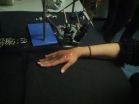(Press-News.org) Scientists at the University of York are playing a key role in the quest for a better understanding of how a recently discovered family of enzymes can degrade hard-to-digest biomass into its constituent sugars.
The enzymes – lytic polysaccharide monooxygenases (LPMOs) – are secreted by both fungi and bacteria and have the ability to 'chip away' at cellulose and other intractable materials. This allows cellulosic materials such as plant stems, wood chips and cardboard waste, as well as other tricky polysaccharides such as insect/crustacean shells, to be broken down.
Finding a way of breaking down cellulosic materials into their constituent sugars to allow them to be fermented through to bioethanol is a key aim for second-generation biofuel development.
In a recent article in the Proceedings of the National Academy of Sciences (PNAS), an international team of researchers, including Professor Paul Walton and Professor Gideon Davies from York, provided important new information on how LPMOs work.
The team – which included scientists from the United States, Denmark and the UK – carried out a detailed investigation of how the enzymes use oxygen from the air to create a very reactive entity. This oxygen species then chips away at cellulose, allowing the difficult-to-degrade biomass to be broken down.
The on-going York research into LPMOs, which is led by Professor Walton and Professor Davies from the Department of Chemistry, is part of Critical Enzymes for Sustainable Biofuels from Cellulose (CESBIC), a collaborative project funded by the European Research Area Industrial Biotechnology network (ERA-IB).
Professor Walton said: "The ability to ferment cellulose is important as it opens up new possibilities in the production of bioethanol from sustainable sources. Through our collaborative research we are starting to uncover exactly the details of how LPMOs work."
The recent research published in the PNAS article, builds on work reported earlier this year in Nature Chemical Biology, which was led by York, and involved Professor Bernard Henrissat, of CNRS, Aix-Marseille Université, Marseille, France. The Nature Chemical Biology article reported on the discovery of an important new family of LPMO able to break down hard-to-digest biomass. This work is funded by the Biotechnology and Biosciences Research Council (BBSRC).
Professor Davies said: "To begin fermenting materials such as wood chips or plant stems, there needs to be a way of breaking into it. The action of an LPMO makes a scratch on the biomass surface which provides an entry point for other enzymes. Understanding how LPMOs work will aid the quest for second generation biofuel production."
The most recent research reported in PNAS was led by Stanford University, USA. As well as York, it involved Novozymes, Denmark and the University of Hull.
INFORMATION: END
York scientists provide new insights into biomass breakdown
2014-06-06
ELSE PRESS RELEASES FROM THIS DATE:
Infection in malaria-transmitting mosquito discovered
2014-06-06
Boston, MA – Researchers have found the first evidence of an intercellular bacterial infection in natural populations of two species of Anopheles mosquitoes, the major vectors of malaria in Africa. The infection, called Wolbachia, has been shown in labs to reduce the incidence of pathogen infections in mosquitoes and has the potential to be used in controlling malaria-transmitting mosquito populations.
"Wolbachia is an interesting bacterium that seems perfectly suited for mosquito control. However, there were strong doubts that it could ever be used against field Anopheles ...
Three gene networks discovered in autism, may present treatment targets
2014-06-06
A large new analysis of DNA from thousands of patients has uncovered several underlying gene networks with potentially important roles in autism. These networks may offer attractive targets for developing new autism drugs or repurposing existing drugs that act on components of the networks.
Furthermore, one of the autism-related gene pathways also affects some patients with attention-deficit hyperactivity disorder (ADHD) and schizophrenia—raising the possibility that a class of drugs may treat particular subsets of all three neurological disorders.
"Neurodevelopmental ...
Asymmetric continental margins and the slow birth of an ocean
2014-06-06
When South America split from Africa 150 to 120 million years ago, the South Atlantic formed and separated Brazil from Angola. The continental margins formed through this separation are surprisingly different. Along offshore Angola 200 km wide, very thin slivers of continental crust have been detected, whereas the Brazilian counterpart margin features an abrupt transition between continental and oceanic crust.
For decades, geoscientists have struggled to explain not only why the amount of thinning and the geometries of opposite rifted continental margin are not symmetric, ...
Text messaging program helps smokers fight the urge to light up
2014-06-06
WASHINGTON, DC (June 6, 2014) — More than 11 percent of smokers who used a text- messaging program to help them quit did so and remained smoke free at the end of a six- month study as compared to just 5 percent of controls, according to a new report by researchers at Milken Institute School of Public Health at the George Washington University (Milken Institute SPH.)
"Text messages seem to give smokers the constant reminders they need to stay focused on quitting," says Lorien C. Abroms, ScD, MA, an associate professor of prevention and community health at Milken Institute ...
Sleep apnea tied to diabetes in large study
2014-06-06
In the largest study to date of the relationship between sleep apnea and diabetes, a new study of more than 8,500 Canadian patients has demonstrated a link between obstructive sleep apnea (OSA) and the development of diabetes, confirming earlier evidence of such a relationship from smaller studies with shorter follow-up periods.
"Our study, with a larger sample size and a median follow-up of 67 months was able to address some of the limitations of earlier studies on the connection between OSA and diabetes," said lead author Tetyana Kendzerska, MD, PhD, of the University ...
Newborns exposed to dirt, dander and germs may have lower allergy and asthma risk
2014-06-06
Infants exposed to rodent and pet dander, roach allergens and a wide variety of household bacteria in the first year of life appear less likely to suffer from allergies, wheezing and asthma, according to results of a study conducted by scientists at the Johns Hopkins Children's Center and other institutions.
Previous research has shown that children who grow up on farms have lower allergy and asthma rates, a phenomenon attributed to their regular exposure to microorganisms present in farm soil. Other studies, however, have found increased asthma risk among inner-city ...
Biomarkers accurately distinguish mesothelioma from non-cancerous tissue
2014-06-06
Philadelphia, PA, June 6, 2014 – Scientists have identified four biomarkers that may help resolve the difficult differential diagnosis between malignant pleural mesothelioma (MPM) and non-cancerous pleural tissue with reactive mesothelial proliferations (RMPs). This is a frequent differential diagnostic problem in pleural biopsy samples taken from patients with clinical suspicion of MPM. The ability to make more accurate diagnoses earlier may facilitate improved patient outcomes. This new study appears in the Journal of Molecular Diagnostics.
"Our goal was to identify ...
Our ability to identify the source of pain varies across the body
2014-06-06
"Where does it hurt?" is the first question asked to any person in pain.
A new UCL study defines for the first time how our ability to identify where it hurts, called "spatial acuity", varies across the body, being most sensitive at the forehead and fingertips.
Using lasers to cause pain to 26 healthy volunteers without any touch, the researchers produced the first systematic map of how acuity for pain is distributed across the body. The work is published in the journal Annals of Neurology and was funded by the Wellcome Trust.
With the exception of the hairless skin ...
Turbulent black holes: Fasten your seatbelts ... gravity is about to get bumpy!
2014-06-06
Fasten your seatbelts – gravity is about to get bumpy.
Of course, if you're flying in the vicinity of a black hole, a bit of extra bumpiness is the least of your worries. But it's still surprising. The accepted wisdom among gravitational researchers has been that spacetime cannot become turbulent. New research from Perimeter, though, shows that the accepted wisdom might be wrong.
The researchers followed this line of thought: Gravity, it's thought, can behave as a fluid. One of the characteristic behaviours of fluids is turbulence – that is, under certain conditions, ...
YbeY is essential for fitness and virulence of V. cholerae, keeps RNA household in order
2014-06-06
YbeY is a conserved protein that is present in most bacteria. A study published on June 5th in PLOS Pathogens examines the function of YbeY in the cholera bacterium and reveals critical roles in RNA metabolism in this and other pathogenic bacteria.
Graham Walker, from the Massachusetts Institute of Technology, USA, and colleagues previously studied E. coli YbeY and found that it acts as an "RNase"—a protein that deliberately and specifically cuts RNA molecules and thereby regulates their availability and activity. Turning to Vibrio cholerae to examine the role of YbeY ...

